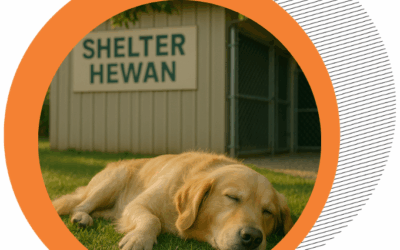
From Vomiting to Weakness: Is Your Pet in Danger?
By: AWI Team
Translator : AWI Team
Monitoring your pet’s health is your responsibility as a Pawparents. The obstacle that often occurs is that Pawparents have difficulty understanding what the danger signs are in anabul. This danger sign, if not handled immediately, will lead to death.
Pawrents need to know, pets cannot express pain or discomfort. However, they give certain signs, even some symptoms indicate that they are in need of medical attention.
Image 1. JAAN Domestic Shelter

Here are some signs that your pet may need to be taken to the vet immediately:
1. Changes in Eating and Drinking Patterns
Don’t ignore it if your pet suddenly eats/drinks less than usual. Loss of appetite/drinking can be an indication of a health problem. Drastic changes in pet’s eating and drinking habits could indicate an infection or other illness. Consult a doctor immediately if your pet experiences this.
2. Unexplained Weight Loss
Significant weight loss for no apparent reason is a serious warning sign. This symptom could indicate problems such as worms, cancer or other chronic diseases. If your pet experiences this, please see your Veterinarian immediately for further evaluation.
3. Lethargy or Lack of Energy
If your pet is normally active but suddenly becomes limp or lackluster, they could be experiencing health issues. Prolonged weakness can be a sign of anemia, heart disease, or other serious conditions. Consult your Veterinarian immediately for further examination.
4. Coughing, Sneezing, or Difficulty Breathing
Coughing, sneezing, or difficulty breathing could indicate respiratory problems such as respiratory infections, bronchitis, or heart disease. If your pet shows any of these symptoms, consult a veterinarian immediately.
5. Changes in Urination
Diarrhea, constipation, or changes in urination frequency can be a sign of digestive or urinary system problems. Also, pay attention if there is blood in the pet’s urine or feces. That’s a strong sign that the pet is in need of immediate medical attention.
Read Also : Better To Adopt
6. Wounds or Swelling that Won’t Heal
A wound or swelling that doesn’t heal in a reasonable amount of time could be a sign of infection or even cancer. Pets that frequently lick or bite certain areas may be trying to relieve pain or discomfort. Pawrents should see a Veterinarian immediately if they see this in their pet.
7. Changes in Behavior
Behavioral changes such as sudden aggression, anxiety, or withdrawal can indicate that your pet is experiencing pain or stress. Behavioral changes are often the first sign of health problems.
8. Skin and coat problems
Red, itchy, scaly skin or shedding fur can indicate allergies, infections or other skin problems. If your pet is constantly scratching or biting itself, get it checked by a veterinarian immediately.
9. Excessive Vomiting
While occasional vomiting can be considered normal, excessive or chronic vomiting is a warning sign. It could indicate digestive problems, infection, or even poisoning. If your pet vomits more than once a day or shows signs of dehydration, don’t hesitate to consult a veterinarian.
Read Also : WHY IS STERILIZATION IMPORTANT/NEEDED?
10. Difficulty Moving or Pain
Does your Anabul seem to be in pain when moving, such as limping or not wanting to walk? Be on the lookout, Pawrents. Because this could be a sign of problems with joints, bones, or muscles. These problems can require immediate treatment to prevent further damage.
Here are some signs that your pet may need to be taken to the vet immediately:
1. Changes in Eating and Drinking Patterns
Don’t ignore it if your pet suddenly eats/drinks less than usual. Loss of appetite/drinking can be an indication of a health problem. Drastic changes in pet’s eating and drinking habits could indicate an infection or other illness. Consult a doctor immediately if your pet experiences this.
2. Unexplained Weight Loss
Significant weight loss for no apparent reason is a serious warning sign. This symptom could indicate problems such as worms, cancer or other chronic diseases. If your pet experiences this, please see your Veterinarian immediately for further evaluation.
3. Lethargy or Lack of Energy
If your pet is normally active but suddenly becomes limp or lackluster, they could be experiencing health issues. Prolonged weakness can be a sign of anemia, heart disease, or other serious conditions. Consult your Veterinarian immediately for further examination.
4. Coughing, Sneezing, or Difficulty Breathing
Coughing, sneezing, or difficulty breathing could indicate respiratory problems such as respiratory infections, bronchitis, or heart disease. If your pet shows any of these symptoms, consult a veterinarian immediately.
5. Changes in Urination
Diarrhea, constipation, or changes in urination frequency can be a sign of digestive or urinary system problems. Also, pay attention if there is blood in the pet’s urine or feces. That’s a strong sign that the pet is in need of immediate medical attention.
Read Also : Better To Adopt
6. Wounds or Swelling that Won’t Heal
A wound or swelling that doesn’t heal in a reasonable amount of time could be a sign of infection or even cancer. Pets that frequently lick or bite certain areas may be trying to relieve pain or discomfort. Pawrents should see a Veterinarian immediately if they see this in their pet.
7. Changes in Behavior
Behavioral changes such as sudden aggression, anxiety, or withdrawal can indicate that your pet is experiencing pain or stress. Behavioral changes are often the first sign of health problems.
8. Skin and coat problems
Red, itchy, scaly skin or shedding fur can indicate allergies, infections or other skin problems. If your pet is constantly scratching or biting itself, get it checked by a veterinarian immediately.
9. Excessive Vomiting
While occasional vomiting can be considered normal, excessive or chronic vomiting is a warning sign. It could indicate digestive problems, infection, or even poisoning. If your pet vomits more than once a day or shows signs of dehydration, don’t hesitate to consult a veterinarian.
Read Also : WHY IS STERILIZATION IMPORTANT/NEEDED?
10. Difficulty Moving or Pain
Does your Anabul seem to be in pain when moving, such as limping or not wanting to walk? Be on the lookout, Pawrents. Because this could be a sign of problems with joints, bones, or muscles. These problems can require immediate treatment to prevent further damage.
CONCLUSION:
Identifying early signs that your pet needs medical attention can help prevent more serious health problems. If you notice any of the above signs, consult a veterinarian immediately for proper diagnosis and treatment. Your pet’s health is Pawrents’ responsibility. Quick action can make a big difference in their lives.
Source :
ASPCA Pro, Feline Foster Care Guide, https://www.aspcapro.org/sites/default/files/aspcapro-feline-foster-care-guide.pdf
Nancy Kay, Understanding Vomiting in Dogs, https://www.pethealthnetwork.com/dog-health/dog-diseases-conditions-a-z/understanding-vomiting-dogs#:~:text=It%27s%20normal%20and%20reasonable%20for,and%20deserving%20of%20medical%20attention.
Related Post :
Why Is an Isolation Room Important in Animal Shelters?
By : Drh.Mikeu Paujiah, M.MIn animal shelter management, there is one facility that is often considered unnecessary or postponed until funding is available: the isolation room.In fact, an isolation room is not merely an optional addition—it is a vital component in...
Not Just a Fashion Statement: Carrying Cats Should Prioritize Welfare, Not Aesthetics
By: drh.Mikeu Paujiah, M.MIn recent years, we have increasingly seen a trend on social media: cats being taken for walks in transparent backpacks that fully expose their bodies to the outside. At first glance, it looks cute, stylish, and adorable. However, when viewed...
More Than Just Style: Ethical Ways to Carry Cats According to Animal Welfare Principles
By : drh. Mikeu Paujiah, M.M.In the era of social media, we often see cats being taken out in transparent backpacks that display their entire bodies to the world. Cute? Perhaps. But is it comfortable and safe for cats? Not necessarily.Cats are highly sensitive beings....
Capacity for Care: The Overlooked Responsibility in Indonesian Animal Shelters
By: Drh. Mikeu PaujiahBehind the good intentions of many animal shelter founders in Indonesia lies a fundamental mistake with long-term consequences:They take in too many animals without calculating the actual capacity for care they can handle.In international terms,...
How to Determine Capacity for Care (C4C) in Animal Shelters?
By: drh.Mikeu Paujiah, M.MAfter understanding that determining Capacity for Care (C4C) is an essential aspect often overlooked by shelter managers in Indonesia, the next question is: How do we determine it in a practical and responsible way?Capacity for Care is not...
Animal Shelters in Indonesia: Challenges & Hopes Toward Animal Welfare
By: drh.Mikeu Paujiah MurIn recent years, more and more people in Indonesia have felt moved to build shelters to house abandoned animals. They come from various backgrounds—volunteers, small communities, even individuals who feel called to help suffering...





